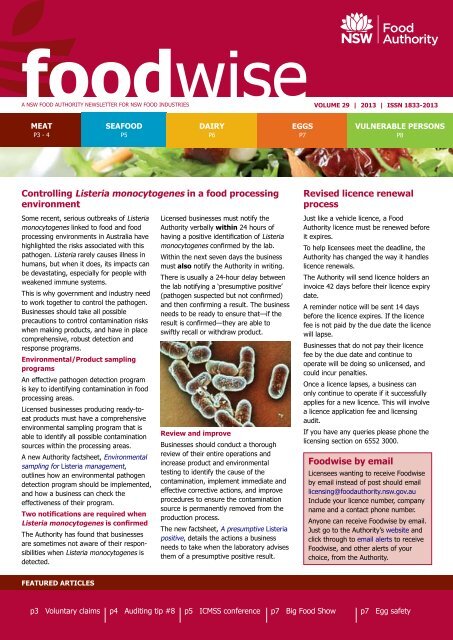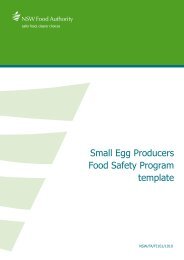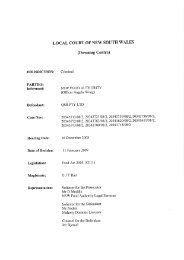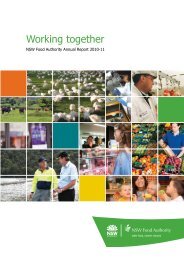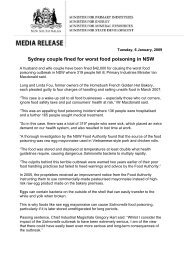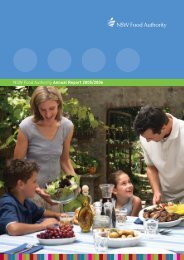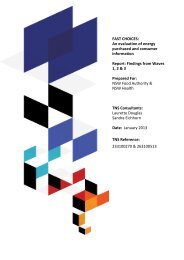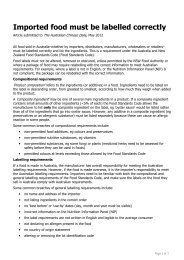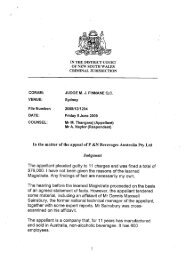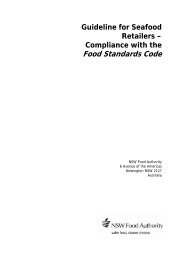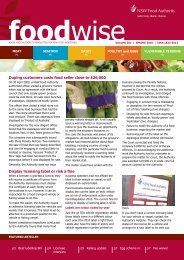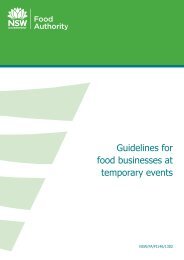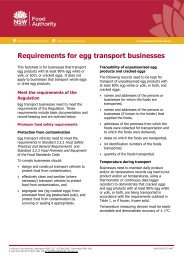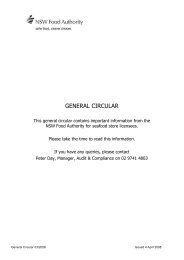Foodwise volume 29 - NSW Food Authority - NSW Government
Foodwise volume 29 - NSW Food Authority - NSW Government
Foodwise volume 29 - NSW Food Authority - NSW Government
You also want an ePaper? Increase the reach of your titles
YUMPU automatically turns print PDFs into web optimized ePapers that Google loves.
MeatSeafood and shellfish4continued from page 3Producers’ <strong>Food</strong> Safety Programs mustadequately address all hazards andprocessing parameters must be constantlyreviewed. It is crucial to act on nonconformitiesimmediately; any delaysallow the problem to blow out.Microbiological hazards require carefulmonitoring throughout the processingchain. There are clear guidelines forfollow-up action if required.Information and resources for poultryproducers are available:www.foodauthority.nsw.gov.au/industry/industry-sector-requirements/meat/poultry/The <strong>NSW</strong> <strong>Food</strong> Safety Schemes Manualdetails how to conduct pathogen testing.Auditing tip #8 Environmental testing can help avoid pathogen growthProduct testing is required for licensees inthe dairy, meat, plant products, seafoodand egg industries.The requirements for each industry aredetailed in the <strong>NSW</strong> <strong>Food</strong> Safety SchemesManual which outlines, scheme by scheme,the requirements for testing and the resultlimits. Licensees need to make sure thattheir product testing procedures followthese requirements and are documented intheir <strong>Food</strong> Safety Program (FSP).Each food business should ensure thatstaff who are responsible for producttesting have the skills and knowledge tocollect, package, store and transport thesamples and to interpret the results.Failed tests must be notifiedThe licensed business must notify the<strong>Authority</strong> when a product test exceeds thelimits listed in the Manual:1. Phone the <strong>Authority</strong> within 24 hours ofthe positive result being confirmed bythe laboratory2. Send written notification of the resultto the <strong>Authority</strong> within seven days ofobtaining the result.To avoid confusion, each business shouldbe clear who is responsible for notifyingthe <strong>Authority</strong> if there is a positive result.It is a good idea to write the name(s) intothe testing schedule of the FSP.Auditors will check that businesses areconducting product tests at the correctfrequency, and that—if a product test ispositive—the <strong>Authority</strong> has been notifiedwithin the required timeframes.Environmental tests can help avoidproduct contaminationShould your facility receive a positivepathogen result, environmental testingmay help to identify unclean areas orareas harbouring pathogens.Environmental swabs are a quick indicatorto verify that your facility’s cleaning andsanitation program is effective. Usingenvironmental swabs can help prevent theBusinesses improve food safety, and stay off the Name & Shame registerThe <strong>Authority</strong>’s online Name and Shameregister, which names businesses thatfail to meet food safety standards, hasreceived well over 7 million hits since itwas established in 2008.The most common food safety breachesunder the <strong>Food</strong> Act 2003 are:• cleaning and sanitation (35%)Meat Industry Consultative Council report, March 2013The compliance report, July toDecember 2012, noted a substantialproportion of failures still coming fromthe meat retail sector. The <strong>Authority</strong>has implemented an audit improvementprogram to deal with businesses with poorcompliance records.A paper prepared by the poultry industryrepresentatives re improving compliancewith animal welfare standards in<strong>NSW</strong> abattoirs was discussed. Memberssupported stringent training programs forall staff. The <strong>Authority</strong> will arrange furthermeetings with industry representatives inthe red meat and poultry meat sectors toaddress specific concerns.A paper outlining the <strong>Authority</strong>’s• temperature control (13%)• pest control – infestations, droppings(13%)• hand washing offences (13%)• protection from contamination –storage, personal hygiene (11%)The number of food businesses appearingon the register has almost halved in threecompliance strategy for productsubstitution was presented.The <strong>Authority</strong>’s paper on <strong>NSW</strong> lambbranding regulations was noted. AMICwill address the issue at future meetingsand provide further updates.The National Poultry Standard (PPPS)is at a critical stage of implementation and<strong>NSW</strong> Farmers’ Association is arrangingmeetings with poultry farmers. MICCpoultry members raised concerns aboutthe requirements of the processormicrobiological verification program;further discussions will be held. Workis underway to reference the AustralianStandards in the FSANZ <strong>Food</strong> StandardsCode as part of the meat PPPS.risk of product contamination.Environmental pathogen testing is only alegal requirement for the meat industry.(See <strong>NSW</strong> <strong>Food</strong> Safety Schemes Manualfor details.)To help the meat industry deal withListeria, see the <strong>Authority</strong>’s Listeriamanagement program, www.foodauthority.nsw.gov.au/_Documents/industry_pdf/listeria-management-program.pdfTo help with effective environmentaltesting, Environmental swabbing: Aguide to method selection and consistenttechnique, is also now available.You can find the <strong>NSW</strong> <strong>Food</strong> SafetySchemes Manual on each relevant industrypage on the <strong>Authority</strong>’s website, ortype ‘<strong>Food</strong> Safety Schemes Manual’ intothe search box at the top right of any<strong>Authority</strong> web page.years. This shows the campaign is havingthe desired effect—fewer food outlets arebreaking the rules.In 2011–12, 785 food businesses appearedon the Name and Shame register (1337penalty notices) compared to 1309 foodbusinesses in 2009–2010 (23<strong>29</strong> penaltynotices).Molluscs in spotlightThe <strong>NSW</strong> <strong>Food</strong> <strong>Authority</strong> was host toover 200 delegates from 30 countriesfor the 9th International Conference onMolluscan Shellfish Safety (ICMSS)—theindustry’s premier global event—held inSydney in March.The diverse group of shellfish producers,scientists and regulators sharedinformation about public health protectionand industry sustainability.Minister for Primary Industries, KatrinaHodgkinson, opened the conference,declaring her pride in <strong>NSW</strong>’s reputation asa leading provider of safe, fresh and highquality shellfish. ‘This has been achievedthrough the hard work and dedication ofthe industry itself and this government’scommitment,’ said the Minister.The <strong>NSW</strong> government supports the state’sshellfish industry through the provisionof research and support services, byprotecting water quality and by overseeingindustry food safety programs.The <strong>NSW</strong> <strong>Food</strong> Safety Scheme for shellfishhas been in operation since 2000.Licence renewalsShellfish licence holders will receivetheir licence renewal invoice 42 daysbefore the current licence expiry date.Your licence can only be renewed if thelicence renewal invoice is paid by thedue date.See item New licence renewal processon p1.Give us feedbackUsers of our website now have a quickand easy way to give feedback on thecontent of that page.An orange ‘Feedback’ box is located onthe right border of every page. Click on itand choose an option to give feedback.If you elect to include your email addresswe can give you a response.Aquaculture awarded at Sydney Royal Fine <strong>Food</strong> ShowProducing high quality food under whatcan be at times adverse natural conditionsis a challenge for most food producers,none more so than for the aquacultureindustry.The <strong>Authority</strong> values the work of industryin producing such high quality products,and the diligence with which producersfollow the harvest area managementprogram, in place to deliver safe food toconsumers.The <strong>Authority</strong> was proud to once againpresent medal-winning Tathra Oysters(see interview Vol 26) with the ChampionSydney Rock Oyster trophy it sponsors atthe 2013 Sydney Royal Fine <strong>Food</strong> Show.Two first-time exhibitors, Pialligo Estateand Snowy Mountains Trout Farm, alsotook home major awards and medals.Over 100 aquaculture products werejudged, with 62 medals awarded. Stewardin-Chief,Mr Gerry Andersen, said theresults were impressive.‘The floods had a devastating effect on theNorth Coast oyster farmers but the qualityof the entrants from waters that were notaffected was very high, with the ChampionOyster again an exceptional exampleof what can be achieved with carefulfarming,’ Mr Andersen said.The Show is one of Australia’s premierindustry events, recognising and rewardinginnovation, diversity and excellence inagricultural production.Jo-Anne and Gary Rodely, from Tathra Oysters, receive the <strong>Authority</strong>-sponsored perpetual trophy forChampion Sydney Rock Oyster in the Aquaculture competition from <strong>Authority</strong> CEO, Polly BennettIntroducing Seafood Industry Forum member, Melissa Walker<strong>NSW</strong> Department of Primary Industries representativeMelissa Walker has worked as a Strategy Leader in the AquaticBiosecurity & Risk Management unit within the Biosecurity<strong>NSW</strong> Division of the <strong>NSW</strong> Department of Primary Industriessince 2007, based at the Port Stephens Fisheries Institute.The unit’s key responsibilities include development of policy,management and advisory materials for declared aquaticdiseases and noxious fish and marine vegetation in <strong>NSW</strong>.The Aquatic Biosecurity team works with key stakeholders,including the fishing and aquaculture industry, to minimisepest and disease risks. Melissa’s role includes providing inputto Codes of Practice, technical reports, posters, brochures andwebpages and presenting papers at national conferences andworkshops.Ms Walker has been in various technical and leadership rolesat <strong>NSW</strong> Fisheries/<strong>NSW</strong> Department of Primary Industries since1988, including at Port Stephens, Sydney, Narrandera and Newcastle, giving her a broadbackground in the areas of aquaculture, marine parks and fisheries.5
DairyEggs6Dairy vehicle inspection program a successThe Dairy <strong>Food</strong> Safety Scheme requiresdairy vendors’ vehicles to be inspected bythe <strong>Authority</strong> every three years to ensuremilk is being transported hygienically andcorrectly throughout <strong>NSW</strong>.Following industry consultation, the<strong>Authority</strong> has brought in a program ofvehicle inspection in a central location.More than 100 vehicles were inspected inFebruary, with a very good response tothe call for inspection.Overall, the <strong>Authority</strong> was pleased withthe standards of the vehicles. Only a fewminor structural and hygiene issues wereidentified.<strong>Authority</strong> officers did find three vehiclestransporting milk without the correctlicence, and took action to ensure that thelicensees applied for the correct licenceand were complying with all requirements.The <strong>Authority</strong> will conduct regular vehicleinspection programs each year. Licenseeswho are due for an inspection will berequested by the <strong>Authority</strong> to presenttheir vehicle(s), and are required by lawto do so. Inspections will be availableat various locations to make it easy forlicensees to comply with this requirementand to accommodate their businessarrangements.<strong>NSW</strong> producers enjoy success at RAS Fine <strong>Food</strong> ShowFrom farm to consumer, working withthe dairy industry on ways to improvefood safety is one of the <strong>Authority</strong>’s keypriorities. At every stage of the foodproduction process, the <strong>Authority</strong> supportsthe dairy industry to maintain the higheststandards of operation to minimise risk toconsumers.As part of the <strong>Authority</strong>’s commitment to‘paddock to plate’ food safety and quality,it sponsors the Sydney Royal Cheese andDairy Produce Show.The <strong>Authority</strong>’s Peter Commins hasbeen part of the judging team for theRAS’s annual dairy products competitionfor more than 30 years. His lifetimeexperience in the dairy industrycontributes to the industry excellence onshow at the Sydney Royal.<strong>NSW</strong> producers—many of whom arelicensees with the <strong>Food</strong> <strong>Authority</strong>—featured heavily amongst this year’swinners.<strong>NSW</strong> <strong>Food</strong> <strong>Authority</strong> CEO, Polly Bennett, presents the perpetual trophy forChampion Cheddar Cheese to a delighted Philip Tatzenko, Cheese QualitySupervisor at Bega Cheese, for Bega Strong & BiteyThe <strong>Authority</strong>’s CEO, Polly Bennett,presented the <strong>NSW</strong> <strong>Food</strong> <strong>Authority</strong>Perpetual Trophy for the ChampionCheddar Cheese to Bega Cheese for theirBega Strong & Bitey; and the <strong>NSW</strong> <strong>Food</strong><strong>Authority</strong> Perpetual Trophy for ChampionFancy Cheese to Berry Creek GourmetCheese for their Tarwin Blue.Two of the five cheeses selected for thehighly coveted Australian CheeseboardPerpetual Trophy were from <strong>NSW</strong>: SmallCow Farm Petitvache Brie, and BegaCheese Rindless Cheddar.Bega Cheese dominated the cheddarcheese classes, named Most SuccessfulCheddar Cheese Exhibitor and ChampionCheddar Cheese for its Bega Strong andBitey.<strong>NSW</strong>’s Serendipity Ice Cream was namedMost Successful Ice Cream Exhibitor andwas awarded Champion Ice Cream.Cow And The Moon won Most SuccessfulGelato Exhibitor,Paradise BeachPurveyors wascrowned MostSuccessful DipExhibitor for the fifthyear running, andBrilliant <strong>Food</strong> wonChampion Dip.The Most SuccessfulCream or DairyDessert Exhibitor wasNicholson Fine <strong>Food</strong>swinning a Gold andSilver medal in theMousse Class.Truth about food poisoningA video from the <strong>Authority</strong>, availableon its website, shows consumersthe sometimes ugly truth about foodpoisoning.The video reinforces messages about notcross contaminating food, and will beuseful for food handlers in both retail anddomestic kitchens. It explains the causes,symptoms and onset times of foodpoisoning, featuring:• the risk of food poisoning fromimproperly prepared meals• food poisoning may not be caused bythe last thing you ate• a range of pathogens that cause foodpoisoning• contamination from raw foods toready-to-eat foodsIt addresses the misconception that foodhas to look, smell or taste bad to causefood poisoning, as most bacteria do not,in fact, change the food’s appearance orodour.It highlights key food safety tips: Keepit cold (below 5° C), keep it hot (above60° C), keep it clean, and read the labels.ABARES looks to future foodsDelegates to the Outlook 2013 conferencein Canberra in March were challenged to‘look beyond the farm gate’ to considerthe opportunities through the supplychain to the final consumer.‘Future food, future farming’ was thebackdrop for this year’s conferencewhich is held by the Australian Bureau ofAgricultural and Resource Economics andSciences (ABARES).The forum gives agricultural and foodindustry stakeholders an opportunity todiscuss key issues affecting the outlookfor Australia’s agricultural, fisheries,forestry and food industries.Themes included the issues of sociallicence, animal welfare in meat andlivestock, and building trust in theAustralian seafood industry—all keytopics of interest to the <strong>Authority</strong> and itsstakeholders.Many speakers emphasised the importanceof investment in people, strategicthinking and application of research, aswell as improvements in productivity,market access and sustainability.New investigation protocol for egg-associated outbreaksThere have been several reports in <strong>NSW</strong>of Salmonella outbreaks associated withthe mishandling of eggs in recent years.All are thoroughly investigated by the<strong>Authority</strong>.The process for investigating outbreakslooks at all contributing factorsthroughout the food supply chain—retail,manufacturing and distribution—right backto primary production.In many cases, the problems occur atretail level.The traceback is undertaken to primaryproduction level for completeness and toensure that there are no major issues onfarm.The <strong>NSW</strong> <strong>Food</strong> <strong>Authority</strong> and BiosecuritySouth Australia recently developeda through chain protocol to enableconsistent investigation of theseoutbreaks—from paddock to plate.The protocol was developed to assist instandardised investigation proceduresfor egg-associated outbreaks acrossjurisdictions, and to achieve consistentfindings. This will help the authorities tointerpret the investigation findings andwork out additional control measures toprevent further outbreaks.The protocol is divided into two key parts,investigation at (i) retail, and (ii) on-farm/grading facility level. A standard inspectionchecklist has been developed for each.The investigation checklists includeguidance for obtaining food andenvironmental samples, and collection ofevidence.Big food show at Sydney Royal Easter ShowMinister Katrina Hodgkinson checksout the <strong>Authority</strong>’s standThe retail investigation checklist covers thefollowing critical areas:• Supplier management and productreceival (eggs come from a reputablesupplier and are in good condition)• Process control (focusing on use of rawegg foods)• Product and process validation (foodproduction and handling)• Cleaning and sanitising (skills andknowledge relating to hygiene andsanitation)• Sampling and swabbing (collection ofsamples and critical evidence for theinvestigation)With the introduction of national foodsafety legislation at the primary productionlevel, all egg farms and grading facilitiesmust have appropriate controls in place toreduce Salmonella prevalence.Key areas covered in the farms andgrading facilities checklist include:• External farm environment and feed(addresses biosecurity of farm andfeed/water storage)• Laying shed environment andequipment (egg production facilities/nesting adequate)• Egg processing environment andequipment (grading equipmentfunctioning correctly and cleaned andsanitised)Factors which contribute to the failuresare identified and followed up, and maybe subject to corrective action (CorrectiveAction Request, Improvement Notice,through to Prohibition Orders in severecases).A giant ‘chicken’ and ‘Dirty Bertie’—the dirty egg—were centre stage at the <strong>Authority</strong>’s stand at theSydney Royal Easter Show.The focus was to highlight basic food safety rules:• Keep it hot• Keep it cold• Keep it clean• Check the labelVisitors could enter a competition to win a WeberQ byillustrating one of these tips. See the entries on the<strong>Authority</strong>’s facebook page.Minister for Primary Industries, Katrina Hodgkinson,took time out after presenting the District ExhibitsPerpetual Trophy to visit the <strong>Authority</strong>’s stand and tryher hand at the Good Glen egg game.Plans to improve egg safetyfrom farm to plateFindings from the egg evaluation studyconducted in 2012 highlighted areaswhere businesses performed well, andareas where improvements are needed.Some of the key findings were:• 84% of egg businesses scored an ‘A’audit/inspection rating while 10%scored a ‘B’ rating• over 85% of egg businesses correctlylabelled eggs for wholesale• improved crack detection practiceswere required in 15% of thebusinessesEgg candling to detect cracks• improvements in wash water hygieneand monitoring practices are needed• for system inputs (stock feed andhen drinking water) and biosecuritypractices, there is room forimprovement• Salmonella prevalence was higher inthe egg laying environment (boot/cage swabs and faecal matter) than insamples of system inputs (stock feedand drinking water)In response to the findings the <strong>Authority</strong>plans to:• focus on improving audit andreporting consistency,• continue building its knowledge ofthe egg industry in <strong>NSW</strong>, collectingongoing profiling and monitoring dataas part of audits and inspections,• review industry assistance materials:for example, provide additionalmaterials to help with egg cleaning,and• communicate its through-chainSalmonella risk management strategyfor eggs—as all parts of the chain areresponsible for egg food safety—fromthe egg farm all the way through toretail/ food service and the consumer.7
Vulnerable personsVulnerable Persons <strong>Food</strong> Safety Scheme Consultative Committee, December 2012<strong>Food</strong> safety program compliancereport (2011–12)The <strong>Authority</strong> congratulated the sectoron the excellent results—only an 8.1%failure rate from the first round of audits.Only two businesses failed follow-upaudits. Non-compliance was mostly withthe documented food safety program andprocess control.The <strong>Authority</strong> auditors will be transitioningto the use of iPads for auditing. It isexpected this will improve the auditprocess and consistency, and enablefacilities to receive electronic reports onthe day of audit.Committee members were invited toprovide feedback.Action list items—April 2012 meeting<strong>Food</strong> storage in hospital day roomsMembers noted compliance methodsutilised by HealthShare; these have beenpassed on to auditors.The difficulties of monitoring compliancein clinics or other areas in hospitalsoutside of their direct control werediscussed. Facilities need a procedurethat demonstrates to an auditor thatappropriate food safety measures andcontrols are in place for the areas they docontrol.Members agreed that it would be usefulto circulate the <strong>Authority</strong>’s VP Guideline totheir associations.Data loggersInformation was tabled on how facilitiescan utilise these for recording temperatureinformation. The <strong>Authority</strong> will accept theuse of these devices provided they areoperated and calibrated correctly. Peopleusing data loggers must use the data theyprovide for corrective action.Case study on Listeria-contaminatedmeat in aged, hospital settingTabled to reinforce the importance offollowing the <strong>Authority</strong>’s VP Guideline forhigh risk foods, particularly smallgoods,and of sourcing smallgoods from licensedoperators.Milk rooms in hospital settingsA paper on compliance arrangements forformula and milk rooms at hospitals underthe VP <strong>Food</strong> Safety Scheme was tabled.Dishwasher minimum temperature requirement modifiedThe Guideline for food service tovulnerable persons has been updatedto remove the minimum temperaturerequirement for dishwashers.Instead, it focuses on the correct use andmaintenance of dishwashers in accordancewith the manufacturer’s instructions.To sanitise effectively using a dishwasher:• the dishwasher should be regularlymaintained and serviced• the correct detergent and/or sanitisershould be used for each model• the dishwasher should be operatedusing the hottest rinse cycle available(economy cycle should not be usedas it doesn’t provide a high enoughThe Committee noted:• that existing <strong>NSW</strong> Health policiesprovide an equivalent outcome to therequirements for formula and milkrooms under the <strong>Food</strong> Standards Code,• that existing <strong>NSW</strong> Health internal andexternal audit arrangements providesufficient compliance checks of milk/formula rooms,• the removal of the auditing of milk/formula rooms from the <strong>NSW</strong> <strong>Food</strong><strong>Authority</strong> audit program where thesepolicies and audit procedures are inplace,• these changes will be communicated tothe sector through the VP ConsultativeCommittee, on the <strong>Authority</strong> websiteand by circular to licensees.IPART licensing reviewThe Independent Pricing and RegulatoryTribunal (IPART) recently soughtinformation on all licences in <strong>NSW</strong>, to findif any are unnecessary, have excessiverequirements or are poorly administered.Draft recommendations will be publishedon the IPART website.temperature for sanitising)• items should be visually checked whenremoved from the dishwasher to makesure they are clean• the dishwasher should be regularlycleaned so food residue does notaccumulate<strong>Food</strong> businesses captured under Australian Competition and Consumer legislationSuppliers of consumer goods, includingfood, must provide a written report tothe ACCC within two days of becomingaware of an incident that causes death,serious injury or illness, that was caused,or may have been caused, by the use orforeseeable misuse of a consumer good(including food).The law (Competition and Consumer Act2010) applies to food retailers, distributors,importers, manufacturers and exporters.The law aims to improve response timesand enable early identification of trends.It was enacted after a 2010 ProductivityCommission Report on product safetyrecommended earlier notification togovernment of significant hazards posedby consumer products.All suppliers of consumer goods (includingfood) must report when:• they become aware that a personhas suffered death or serious injuryor illness (‘serious’ meaning an acutephysical injury or illness requiringmedical or surgical treatment by, orunder the supervision of, a qualifieddoctor or nurse), and• the death or serious injury or illnesswas caused, or may have been caused,by the use or foreseeable misuse of theconsumer good.The <strong>Authority</strong> is working with the ACCC tostreamline the reporting process to reduceunnecessary notification of incidents thatdo not meet the criteria of serious illnessor injury.<strong>NSW</strong> <strong>Food</strong> <strong>Authority</strong>6 Avenue of the Americas, Newington <strong>NSW</strong> 2127 | PO Box 6682, Silverwater <strong>NSW</strong> 1811Helpline: 1300 552 406 | Fax: 02 9647 0026 | Email: contact@foodauthority.nsw.gov.auwww.foodauthority.nsw.gov.au


